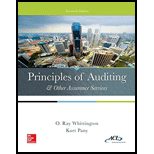
Principles of Auditing & Other Assurance Services (Irwin Accounting)
20th Edition
ISBN: 9780077729141
Author: Ray Whittington, Kurt Pany
Publisher: McGraw-Hill Education
expand_more
expand_more
format_list_bulleted
Question
Chapter 4, Problem 28FOQ
To determine
Identify the correct option for the given statement regarding negligent CPAs.
Expert Solution & Answer
Want to see the full answer?
Check out a sample textbook solution
Students have asked these similar questions
Question: For the year, your company's sales are $425,000, the gross profit is $340,000, and the ending inventory is $92,000. If net purchases are $125,000, the beginning inventory must have been_____.
I need guidance with this general accounting problem using the right accounting principles.
I need help with this financial accounting problem using accurate calculation methods.
Chapter 4 Solutions
Principles of Auditing & Other Assurance Services (Irwin Accounting)
Ch. 4 - Prob. 1RQCh. 4 - Prob. 2RQCh. 4 - Prob. 3RQCh. 4 - Prob. 4RQCh. 4 - Prob. 5RQCh. 4 - Prob. 6RQCh. 4 - Prob. 7RQCh. 4 - Prob. 8RQCh. 4 - Prob. 9RQCh. 4 - Prob. 10RQ
Ch. 4 - Prob. 11RQCh. 4 - Prob. 12RQCh. 4 - Prob. 13RQCh. 4 - Prob. 14RQCh. 4 - Prob. 15RQCh. 4 - Prob. 16RQCh. 4 - Prob. 17RQCh. 4 - Prob. 18RQCh. 4 - Prob. 19RQCh. 4 - Prob. 20QRACh. 4 - Prob. 21QRACh. 4 - Prob. 22QRACh. 4 - Prob. 23QRACh. 4 - Prob. 24QRACh. 4 - Prob. 25QRACh. 4 - Prob. 26QRACh. 4 - Gordon Moore, CPAs, were the auditors of Fox ...Ch. 4 - Prob. 28AOQCh. 4 - Prob. 28BOQCh. 4 - Prob. 28COQCh. 4 - Prob. 28DOQCh. 4 - Prob. 28EOQCh. 4 - Prob. 28FOQCh. 4 - Prob. 28GOQCh. 4 - Prob. 28HOQCh. 4 - Prob. 28IOQCh. 4 - Prob. 28JOQCh. 4 - Prob. 28KOQCh. 4 - Prob. 28LOQCh. 4 - Prob. 29OQCh. 4 - Prob. 30OQCh. 4 - Match the important cases listed below with the...Ch. 4 - Prob. 32OQCh. 4 - Prob. 33OQCh. 4 - Prob. 34PCh. 4 - Prob. 35PCh. 4 - Prob. 36PCh. 4 - Charles Worthington, the founding and senior...Ch. 4 - Prob. 38PCh. 4 - Prob. 39PCh. 4 - Prob. 40PCh. 4 - Prob. 41ITCCh. 4 - Prob. 42RDC
Knowledge Booster
Similar questions
- I need help with general accountingarrow_forwardWhat is the budgeted cost of goods sold for March?arrow_forwardIf the cost of the beginning work in process inventory is $78,500, cost of goods manufactured is $1,050,000, direct materials cost is $340,000, direct labor cost is $265,000, and overhead cost is $410,000, calculate the ending work in process inventory.arrow_forward
- General accounting question and right solutionarrow_forwardJamal Company has liabilities equal to one-third of the total assets. Jamal's stockholders' equity is $80,000. Using the accounting equation, what is the amount of liabilities for Jamal?arrow_forwardDirect labour cost variance: Valora Furnishings sets a standard material cost of $6.60 per chair, based on 5 square feet of fabric at a cost of $1.32 per square foot. In February, a production run of 1,200 chairs resulted in the usage of 6,500 square feet of fabric at a cost of $1.10 per square foot, totaling $7,150. What is the quantity variance resulting from the above production run?arrow_forward
arrow_back_ios
SEE MORE QUESTIONS
arrow_forward_ios
Recommended textbooks for you
 Auditing: A Risk Based-Approach (MindTap Course L...AccountingISBN:9781337619455Author:Karla M Johnstone, Audrey A. Gramling, Larry E. RittenbergPublisher:Cengage Learning
Auditing: A Risk Based-Approach (MindTap Course L...AccountingISBN:9781337619455Author:Karla M Johnstone, Audrey A. Gramling, Larry E. RittenbergPublisher:Cengage Learning Auditing: A Risk Based-Approach to Conducting a Q...AccountingISBN:9781305080577Author:Karla M Johnstone, Audrey A. Gramling, Larry E. RittenbergPublisher:South-Western College PubPrinciples of Accounting Volume 1AccountingISBN:9781947172685Author:OpenStaxPublisher:OpenStax College
Auditing: A Risk Based-Approach to Conducting a Q...AccountingISBN:9781305080577Author:Karla M Johnstone, Audrey A. Gramling, Larry E. RittenbergPublisher:South-Western College PubPrinciples of Accounting Volume 1AccountingISBN:9781947172685Author:OpenStaxPublisher:OpenStax College

Auditing: A Risk Based-Approach (MindTap Course L...
Accounting
ISBN:9781337619455
Author:Karla M Johnstone, Audrey A. Gramling, Larry E. Rittenberg
Publisher:Cengage Learning

Auditing: A Risk Based-Approach to Conducting a Q...
Accounting
ISBN:9781305080577
Author:Karla M Johnstone, Audrey A. Gramling, Larry E. Rittenberg
Publisher:South-Western College Pub

Principles of Accounting Volume 1
Accounting
ISBN:9781947172685
Author:OpenStax
Publisher:OpenStax College
